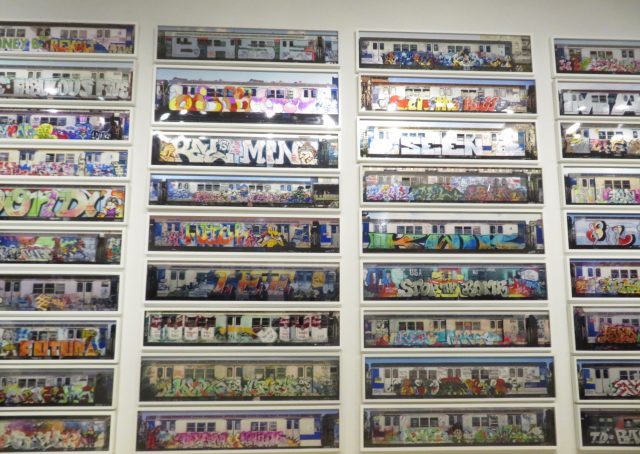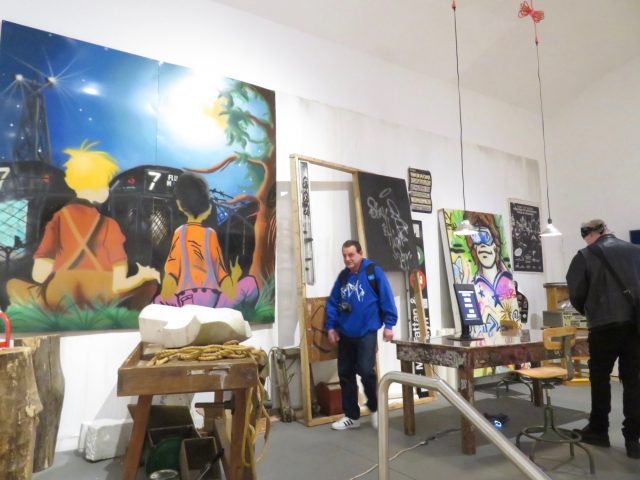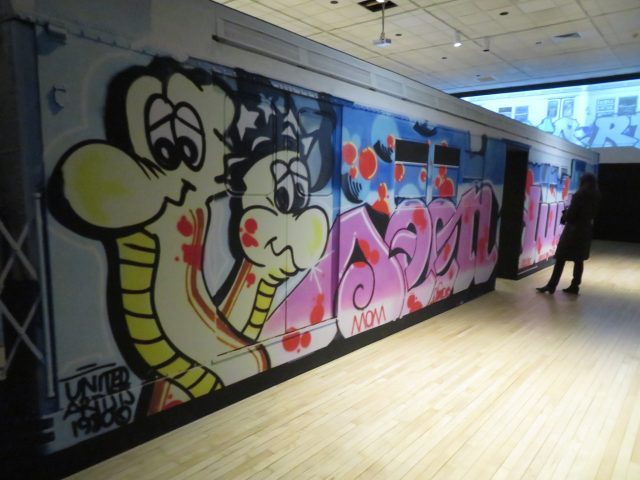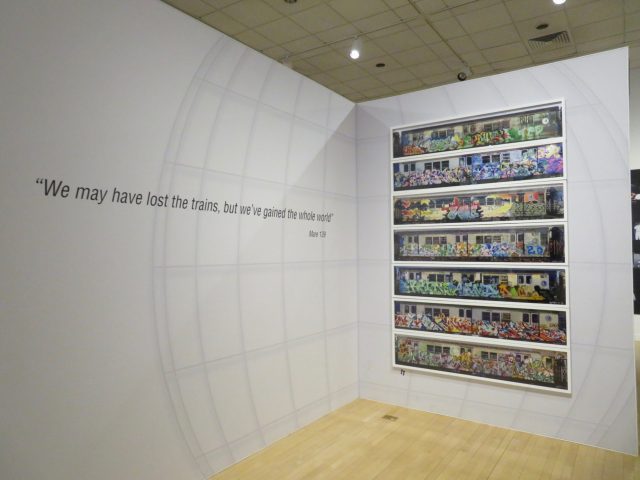
Henry Chalfant’s train photos fill up a wall and more at Bronx Museum exhibit (photo by twi-ny/mdr)
Bronx Museum of the Arts
1040 Grand Concourse at 165th St.
Through March 8, free
718-681-6000
www.bronxmuseum.org
In 1985, the MTA began its Arts for Transit and Urban Design program (now known as MTA Arts & Design), connecting art with public transportation. But before that, art and transit went together like oil and water; hence the name of a fab exhibit that continues at the Bronx Museum through March 8, “Henry Chalfant: Art vs. Transit, 1977–1987,” the title of which was also inspired by the late graffiti artist SHY147. After arriving in New York City from Pittsburgh in 1973 and beginning as a sculptor, Chalfant was quickly enamored with street art, train graffiti, and hip-hop culture and started documenting it. Since train graffiti was impermanent — in addition to the MTA relentlessly trying to clean trains, other taggers and writers would spray paint right over existing tags — his photographs often became the only evidence of the work, so much so that soon graffiti artists would call him up to ask him to take pictures of trains and buildings they’d tagged. Chalfant would go to aboveground stations such as Intervale Avenue and East Tremont on the 2 and 5 lines and take multiple photos with his 35mm camera as trains whizzed by; he would then develop the photos and splice them together to create panoramic shots of full trains.

Duster UA visits re-creation of Henry Chalfant’s SoHo studio (photo by twi-ny/mdr)
This first US museum retrospective, which was curated by Spanish graffiti artist SUSO33 for the Centro de Arte Tomás y Valiente in Madrid, includes dozens of Chalfant’s long, rectangular photographs, hung on the walls one above another, from floor to ceiling, exploding in a glorious blaze of colors and shapes, with wild lettering and cartoonish characters. Among the artists whose work he preserved on film are Dondi, Futura, Lady Pink, Lee Quiñones, Zephyr, Blade, Crash, DAZE, Dez, Kel, Mare, SEEN, Skeme, and T-Kid, some of whom are interviewed for a short film made by multimedia, multidisciplinary artist, producer, and chronicler Sacha Jenkins. I was fortunate enough to watch the film, which is screened continuously within a re-creation of Chalfant’s SoHo studio, alongside a graffiti artist who added biting commentary about some of the figures in the film and pointed out one of his pieces as it passed by.

Life-size cloth murals are arranged like train cars at the Bronx museum (photo by twi-ny/mdr)
In the back room, a series of wooden structures are covered with full-length cloth murals to replicate spray-painted subway cars at actual size, while dozens of Chalfant’s photos are projected at the top of a wall at one end of the room, roaring into the station, then pulling out, complete with sound effects. Also on view are some of Chalfant’s notebooks and more than a hundred photographs of the burgeoning street hip-hop culture as well as newspaper and magazine articles and other ephemera. “The story of the neglected children of NYC, victims of poverty, racism, poor schools lacking art and music instruction who overcame their circumstances with creative expression, is a powerful and inspiring one,” Chalfant says in the beautiful bilingual catalog. “There are plenty of examples in the various cultures that emerged from the mean streets of New York that have been a powerful inspiration to youth everywhere. I’m happy and proud to be bringing it home.” The catalog also features essays by Jenkins, Sharp, SUSO33, and Carlos Mare.
Chalfant, a Stanford grad whose 1984 collaboration with Martha Cooper, Subway Art, is the bible of the genre and who coproduced with director Tony Silver the seminal 1983 documentary Style Wars, did the world a great service by capturing these works of art, which turned drab silver train cars into canvases of free expression, where men and women on the margins could scream out for all to experience. Be on the lookout for such photos as “Dondi,” “EYE JAMMIE by AOne,” “Mad (by Seen),” “Style Wars by Noc 167,” and “Stop the Bomb.”

Exhibit extends past New York and into other cities where hip-hop and graffiti blossomed (photo by twi-ny/mdr)
On March 6, the Bronx Museum will host a free screening of Chalfant’s award-winning 2006 documentary, From Mambo to Hip-Hop: A South Bronx Tale; advance registration is recommended here. Also at the museum is the eye-opening “José Parlá: It’s Yours,” a major solo show by the Miami-born, longtime Bronx resident and former street artist known as “Ease”; his dazzling paintings and collages require up-close viewing to fully experience his exploration of gentrification and systemic racism while also celebrating street art and the Bronx.